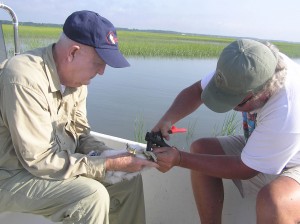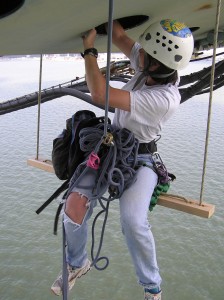PEREGRINE MONITORING
The Center for Conservation Biology in collaboration with the Virginia Department of Game & Inland Fisheries conducts annual monitoring of the Virginia Peregrine Falcon population. The objectives of this program are 1) to track the size and distribution of the breeding population, 2) to determine the productivity of the population, and 3) to mark and identify as many of the individuals in the population as possible.
Each year, all peregrine towers and nest boxes within the Coastal Plain of Virginia are surveyed and monitored to determine the extent of use by breeding pairs. In addition, all structures (e.g. bridges and buildings) known to have supported past peregrine activity or believed to hold promise for supporting breeding pairs are surveyed. Reports of peregrine activity around new structures are also investigated.
All sites known to support peregrine falcons are monitored throughout the breeding season to determine productivity. Every effort is made to determine approximate laying date, clutch size, brood size, and approximate date of fledging. All chicks are banded with individually coded color bands to facilitate future identification in the field. Each year, an attempt is made to identify banded adults within the population.

Mitchell Byrd and Bart Paxton band a peregrine falcon chick near Upshur Bay, VA. Photo by the Center for Conservation Biology.

Elizabeth Long checks a peregrine nest as she hangs beneath the James River Bridge. Photo by Bryan Watts.
